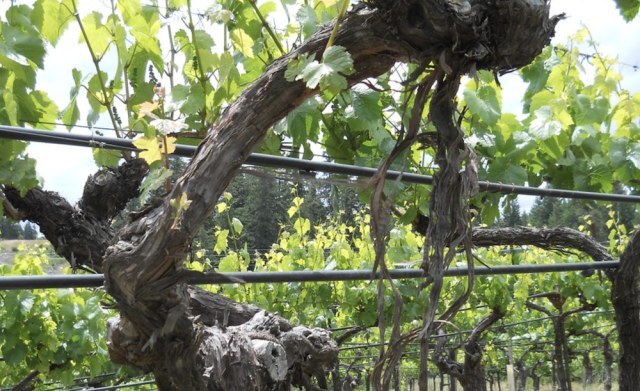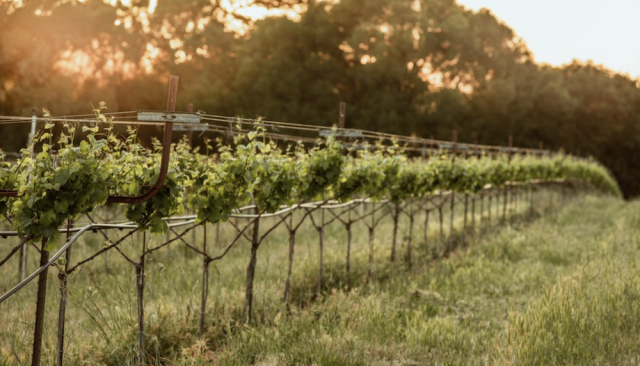This website uses cookies so that we can provide you with the best user experience possible. Cookie information is stored in your browser and performs functions such as recognising you when you return to our website and helping our team to understand which sections of the website you find most interesting and useful.
A simple vineyard strategy cuts water usage by one-third
It’s been called a “no-brainer”…but very few vineyards are doing it. Kathleen Willcox reports on a move which improves water use and also quality.

The increasingly unpredictable climate is making growing grapes an increasingly risky and costly business. France recently lost an estimated $2 billion in wine sales after extreme weather decimated the harvest. In 2022, California farmers lost an estimated $1.7 billion to the drought alone, according to a study conducted by researchers at the University of California.
And despite California’s abnormally wet winter in 2023, which helped replenish reservoirs and groundwater aquifers, experts warn that the wet weather won’t make up for decades of diminished rain and extended periods of drought.
How much water a vineyard needs to produce great wine varies considerably, and while there is an increasing effort to dry farm, the vast majority of California vineyards are irrigated. And the vast majority of vine-growers are eager to reduce their dependence on water, often after running out of water during drought years, and watching their harvest—and bottom line—shrivel in the hot sun.
But what if there was a way to cut down on water usage by about one-third by installing a double drip, or double-poly system of irrigation? And what if, in the process, system not only reduced water usage, but also boosted the quality of all of the grapes in the vineyard? And what if this solution—which, by the way, isn’t brand spanking new—paid for itself in a few years? Everyone would be doing it, right?
As it turns out, not so much.
“People can be very short-sighted,” says Scott Knippelmeir, viticulturalist at Sebastopol’s Integrated Winegrowing, which works with dozens of ultra-premium clients in Napa, Sonoma and, more recently, Mendocino. “If you tell them putting in a system will grow better grapes and save up to 30% on water, they can still be resistant because they have to change the way they do things, and pay to install the system.”
Knippelmeir estimates that “less than 1% of California growers” are utilizing the double poly irrigation systems, but that do tend to be progressive, with wines that fetch high prices.
What Is Double Poly?
“I have worked with double poly throughout my career in different vineyards and wineries,” says Remi Cohen, currently chief executive officer at Domaine Carneros in Napa. “Double poly is essentially a second drip hose that only has emitters where there are weak vines.”
It is, Cohen explains, a useful technique that addresses variability within the block, and the second hose can be used to encourage those vines to catch up.
“Also, if there’s a section of a block that is weaker or needs more water due to soil type or aspect,” Cohen notes, “the second hose can place emitters only in that section, so it can be irrigated more frequently.”
The emitters, Knippelmeir explains, release not just water, but fertilizer. Of the 35 wine clients he works with, about 75% deploy the double-drip system.
At Saracina Vineyards in Mendocino, he estimates that within two years, about 90% of its 100 acres will feature double poly.
“We’re transitioning the vineyard to organic, and you can put organic fertilizers in the drip line, which also helps reduce a vineyard’s carbon footprint and labor costs because no one has to go and apply them manually,” Knippelmeir notes. “We’ve had great results so far here.”
Double Drip Saves Water
At Husch Vineyards in the Anderson Valley, third-generation owner and operator Zac Robinson discovered the double drip system after a severe drought.
“It was awful,” Robinson recalls. “In 2006, Mendocino got hit really hard, and everyone’s water was cut off, even if they had water rights. We sat there with a map of the vineyard and had to choose our favorite and least favorite children essentially. We couldn’t give them all water, so we had to choose. In the end, we lost about one-third of our harvest that year.”
Robinson discovered the little-known, little-used double drip system, and decided they had to give it a shot.
“We initially installed it over two acres,” Robinson says. “It cost us about $1,000 to install, which isn’t zero dollars, but in the grand scheme of things, $500 an acre isn’t much. We discovered that it reduced our water usage by 30% because we could target the vines that really needed the water, without just needlessly watering strong vines that would do just fine without irrigation.”
As soon as he saw the savings, Robinson decided to put the double drip in across all 20 of his estate acres, and the roughly 85 grown elsewhere.
“Without that double drip system in place, we would have run out water and lost part of our harvests multiple years since then,” Robinson notes.
Double Drip Boosts Quality

In addition to saving water, the double poly system boosts vine quality, adherents note.
“We have been using double-poly drip in all vineyards I’ve designed since 2006,” says Aperture and Devil Proof Vineyards vintner Jesse Katz, noting that his primary motivation is to adjust for variations within the same vineyard.
“We always start by doing soil mapping and try to match the best rootstock, clone and varietal to the soil type,” Katz says. “The double drop allows us to make adjustments based on subtle vigor variations, vine by vine. We can give more or less water and nutrients to certain areas to get everything back in balance.”
Anji Perry, viticulturalist and vineyard research director at J. Lohr Vineyard and Wines, says they use double poly on certain vineyards in Paso Robles.
“We knew from the initial soil studies at Shotwell Vineyard done prior to planting that there were going to be differences in water holding capacity of the soils between the tops of the hills and the bottom,” says Perry. “Our primary reason for developing the irrigation system with double poly was to hopefully be able to minimize vigor variability within a block and thereby increase quality. We also are very conscious of our water use, and being able to only water the portions of a block that really need it helps us conserve a precious resource.”
Double poly, Knippelmeir says, “saves water, saves money on nutrients and increases quality levels and harvest levels. Once you have the economics explained to you, it seems like a no-brainer, right?
Easy solutions to vexing problems often seem too good to be true. But double-poly, it appears, is not. Hopefully more vintners will tap this tried-and-true solution, reducing their water usage and making better wine, a double wine win for all of us.

